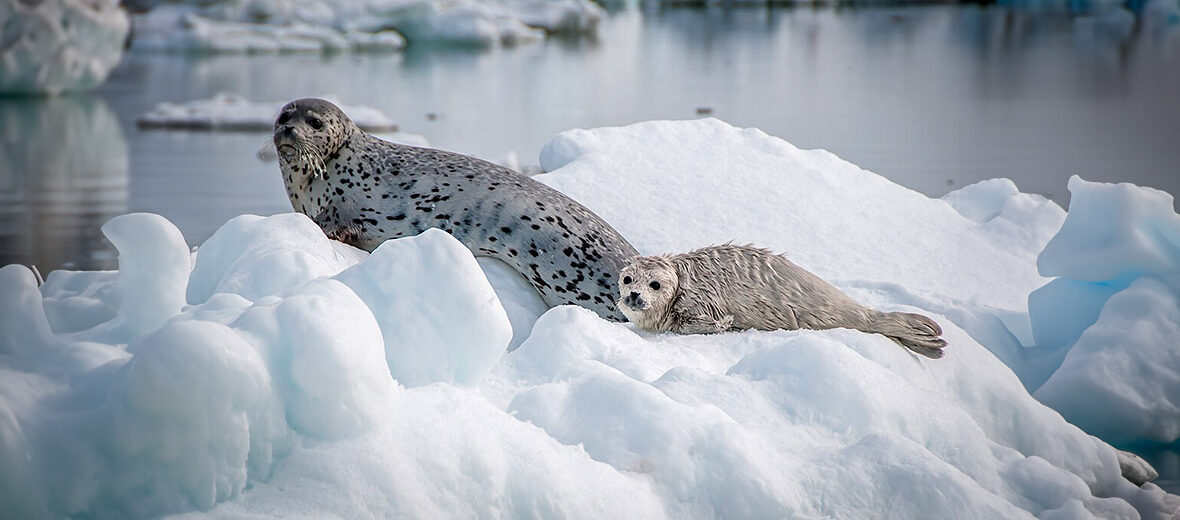
The spotted seal, aka the larga seal or largha seal, is considered a “true seal” (lacking external ear flaps and has a stiff, hair-like coat). They can be found among the chilly waters of the north Pacific Ocean and accompanying seas. They face the threats of habitat loss at the hands of residential and commercial developments; overfishing; bycatch (getting caught in long lines and gill nets); water & air pollution; and climate change, which warms the waters, melts the pack ice, and drives their food sources away; as well as affecting the breeding cycle of their food sources. However, these critters are listed as Least Concern by the IUCN.
First the Stats…
Scientific name: Phoca largha
Weight: Up to 250 lbs.
Length: Up to 5 feet
Lifespan: Up to 35 years
Now on to the Facts!
1.) There are approximately 640,000 spotted seals remaining, to date, and their population trend is unknown.
2.) Spotted seals are sometimes mistaken for harbor seals, since they look similar and often dwell amongst each other in overlapping territories.
3.) Their scientific name hails from the Greek word for seal, “phoce”, and “larga” is the term used by the Siberian Tungus people for these seals.
4.) Alaskan Eskimo names include: issuriq (from the Central Alaskan Yup’ik language), qasigiaq in Inupiaq, and gazigyaq in St. Lawrence Island Yupik.
5.) They are about the same size as both harbor and ribbon seals.
But wait, there’s more on the spotted seal!
6.) Their snout is long and narrow, like that of a dog.
7.) These seals have 34 teeth.
Did you know…?
A group of seals is called a bob, harem, or herd.
8.) In the warmer summer months they dwell in the open ocean or on nearby shores.
9.) These critters tend to shy away from humans approaching them.
10.) They can be solitary or gregarious. The largest herds in Alaska are found near Cape Espenburg in Kotzebue Sound, in Kasegaluk Lagoon in the Chukchi Sea, and in Kuskokwim Bay on shoals and sandbars, where thousands may conglomerate.
But wait, there’s still more on the spotted seal!
11.) These seals reach sexual maturity at the age of 4 years.
12.) Breeding season lasts from January – mid-April.
Did you know…?
Pups measure up to 39 inches and weigh in at about 26 lbs.
13.) Spotted seals are believed to be monogamous (mate for life).
14.) Females undergo up to a 10 month gestation (pregnancy) that yields a single pup.
15.) Pups are weaned in up to 6 weeks.
But wait, there’s still a little more on the spotted seal!
16.) The spotted seal can dive to depths of up to 980 feet.
17.) Juveniles tend to eat mostly krill and small crustaceans, while adults eat a wide variety of fish including: herring, arctic cod, pollock, and capelin.
Did you know…?
They form “family” groups that consist of a male, a female, and a pup during the breeding season.
18.) While capable of producing barks, growls, moans, and roars, these seals are typically rather quiet, unless in larger bobs.
19.) Satellite tracking has discovered that the yellow sea population and some others migrate up to 2,100 miles each year!
20.) The main threats to these seals in China are global warming, industry noise, marine traffic, ocean pollution, and poaching for aquarium exhibits.
21.) Sleeper sharks, orcas, sea lions, walruses, polar bears, brown bears, wolves, arctic foxes, eagles, ravens, gulls, and humans all prey on these seals.
Now a Short Spotted Seal Video!
Be sure to share & comment below! Also, check out the Critter Science YouTube channel. Videos added regularly!
Want to suggest a critter for me to write about? Let me know here.
Some source material acquired from: Wikipedia & IUCN
Photo credit: NOAA Fisheries




